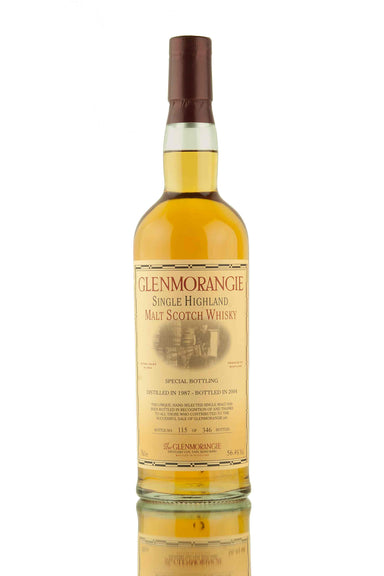
Glenmorangie Sale Of The Company (Graham Eunson)
This unique, hand selected single malt has been bottled in recognition of and thanks to all those who contributed to the successful sale of Glenmor...
View full details
Glenmorangie as a brand has enjoyed considerable success following a makeover from its current owners Moet Hennessy Louis Vuitton, who purchased the distillery in 2004. The deal which was worth...
Glenmorangie as a brand has enjoyed considerable success following a makeover from its current owners Moet Hennessy Louis Vuitton, who purchased the distillery in 2004. The deal which was worth an impressive £300 million at the time, included the Ardbeg and Glen Moray distilleries with the latter sold off shortly afterwards.
The preceding years since its acquisition, Glenmorangie has departed from its 16 men of Tain and traditional tartan apparel in favour of new markets and French style boutique revamp. This new found confidence has been aptly timed with an increased interest in single malts as a whole and their perceived luxury status. An ideal marriage has been formed and if one distillery has embraced and captured this new era of whisky perfectly, then its Glenmorangie.
In comparison its origins in 1843 on the outskirts of the Highland town of Tain are far humbler. Overlooking the Dornoch Firth, this was formerly a farm brewery set amongst the fertile lands formerly known as Morangie that dated back to the early 1700’s. With the arrival of the Excise Act in 1823, former illicit distillers and entrepreneurs took up the challenge of funding and operating a legal distillery. In 1843, brothers John and William Mathesen applied for a distilling licence for the site and money being tight had to improvise once their application was accepted. The first pair of stills at Glenmorangie were former gin stills, which explains their size and tall slender necks, which today form a key component of the light spirit produced at the distillery. Prior to Glenmorangie, William had been involved at Balblair distillery, which is a couple of miles away at Edderton. Come 1887 the Glenmorangie Distillery company is established and improvements are made at the distillery, which form the majority of what you’ll see today externally.
The distillery is a success partially as it looks beyond the confines of its of domestic market and by the 1880’s is exporting its wares and being one of the earliest single malts. By 1917 it attracts the attention of Edinburgh blending firm MacDonald & Muir, who purchase the distillery and form a partnership before becoming full owners in the 1930. Sadly, the distillery closes soon after due to the economic conditions of the Great Depression and Prohibition, but by 1936 the men of Tain are hard at work once again.
The tours at Glenmorangie today are very efficient and take you through the various stages of production with no photography allowed. Many of the external buildings maintain a traditional character but the still house due to various expansions has lost its appeal although the sheer size of the Glenmorangie stills is an impressive sight. In 1979 their number was doubled to 4, before improvements in 1990 resulted in the 8 stills you can see on the tour today. The 70’s also introduced a light-grains plant to the distillery, whilst the 90’s witnessed the arrival of the visitor centre which is a major attraction thanks partially to the location of the distillery, which is alongside the main road in the area.
The distillery is now capable of producing 6 million litres annually almost all of which is destined to the single malt market. Under previous ownership it supported the Highland Queen range of whiskies but Moet Hennessy are only really active in the single malt realm. There are very few bottlings of the distillery from independents as the company practises the art of teaspooning its malt when selling casks on. This means a teaspoon of whisky from another distillery is added to the cask preventing it from being sold as Glenmorangie. Instead if you see a bottling called Westport then you know it is actually a teaspooned Glenmorangie.
The Glenmorangie spirit is elegant, dry and light, producing a fine whisky even at a young age. Nowadays the core entry level bottling is the 10-year-old, with the Signet offering a more elegant twist thanks to its innovative use of local malt. The distillery has led the industry when it comes to cask finishing its whisky through a variety of materials including the first which was a Port Wood finish in 1994. Since production was expanded in 2008, Moet Hennessy has continued to release special bottlings annually featuring a specific cask finish. These have proved popular with collectors and enthusiasts wishing to explore the influence of a cask on the original spirit. 2016 witnessed the arrival of the Tayne (Amontillado sherry casks), Milsean (Portuguese wine casks) and Tarlogan (virgin oak) and 2017 will herald new finishes with the first being the Bacalta that uses sun-baked Malmsey Madeira casks.
 Save Liquid error (snippets/product-badge line 32): Computation results in '-Infinity'%
Save Liquid error (snippets/product-badge line 32): Computation results in '-Infinity'%
This unique, hand selected single malt has been bottled in recognition of and thanks to all those who contributed to the successful sale of Glenmor...
View full details
